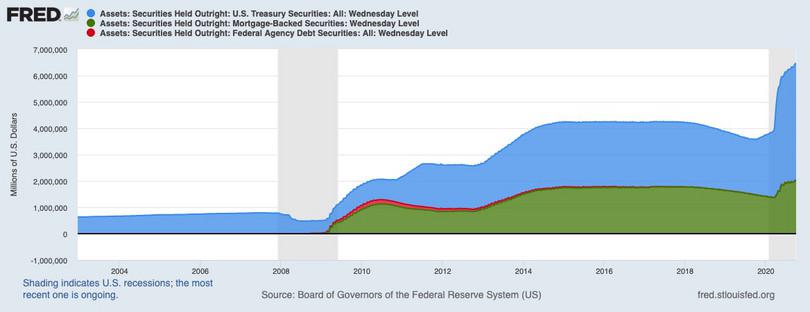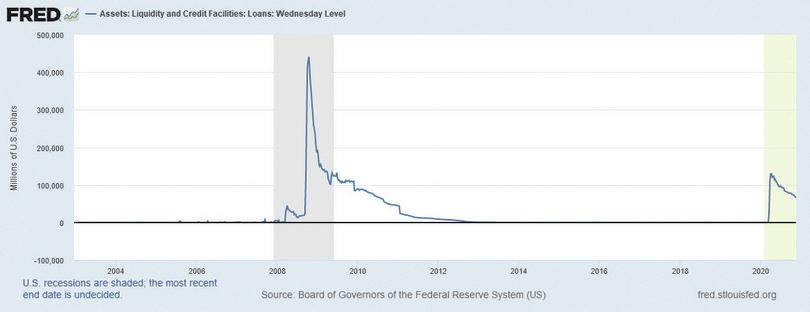Financing American government
7 The Fed’s role in a crisis
Section 13(3) of the Federal Reserve Act allows for measures under ‘unusual and exigent circumstances’ that involve lending to nonbanks, including municipalities and businesses, as well as purchases of a broad range of assets. This power was aggressively exercised during the global financial crisis of 2008, and again in response to the COVID-19 pandemic in 2020.
Figure 9 shows the evolution of the asset side of the Fed balance sheet since 2003. Prior to the global financial crisis, treasuries were the only significant class of asset held, and holdings of treasuries were relatively stable. As a reaction to the 2008 crisis, the Fed sharply increased its purchases of treasuries, and also began to buy large quantities of mortgage-backed securities guaranteed by governmental agencies. As a result, the size of the balance sheet increased significantly, in a manner that was not reversed after the crisis. A further sharp increase occurred as the economic effects of COVID-19 began to be felt, and this process remains ongoing.

Figure 9 Assets held by the Federal Reserve (weekly).
‘Assets: Securities held outright: US Treasury Securities: All: Wednesday Level [TREAST]’, Board of Governors of the Federal Reserve System (US), retrieved from FRED, Federal Reserve Bank of St. Louis, 25 November 2020.
- liquidity
- Ease of buying or selling a financial asset at a predictable price.
While Figure 9 shows assets purchased outright by the Fed, it does not reveal a number of aggressive lending actions that were conducted through newly created liquidity facilities that channeled funding directly to businesses and municipalities. These appear on the balance sheets as loans, with amounts shown in Figure 10.

Figure 10 Fed lending through liquidity and credit facilities (weekly).
‘Assets: Liquidity and Credit Facilities: Loans: Wednesday Level [WLCFLL]’, Board of Governors of the Federal Reserve System (US), retrieved from FRED, Federal Reserve Bank of St. Louis, 24 November 2020.
- credit
- The granting of money or something else of value in exchange for a promise of future repayment. Source: Federal Reserve Bank of St. Louis Education Glossary.
Figure 10 adds together loans made by the Fed to financial and non-financial institutions, including state and local governments, through the creation of so-called facilities designed specifically for this purpose. Some of these loans, for instance to businesses that go bankrupt, will never be repaid. In this case, the Treasury would have to cover the losses of the Fed. During the 2008 global financial crisis, the facilities were used primarily to channel funding to financial institutions to maintain liquidity. Currently, in the face of the pandemic, the goal is to provide credit to cities, states, and businesses whose revenues have fallen sharply.
These unconventional programs are temporary but can be large, with a $100 billion in outstanding loans at the highest point in 2020 to date. Alongside Congress and the Treasury, the Federal Reserve has been trying to use its powers ‘forcefully, proactively, and aggressively’.
Despite these efforts, the American economy contracted by about 33% (at an annual rate) in the second quarter of 2020, and the unemployment rate is in double digits, higher than at any point since the Great Depression. The economic calamity that we would have faced in the absence of such aggressive intervention is simply unfathomable.
Exercise 2 The Fed’s role in a crisis
- Have a look at the Fed’s asset purchasing behavior using the information in Figure 9 as a guide. How do the types of assets and the speed of purchases differ as a reaction to the 2008 global financial crisis and the 2020 COVID-19 pandemic?
- Discuss why, in an emergency situation, the Fed must step in and use liquidity and credit facilities to uphold the economy.

